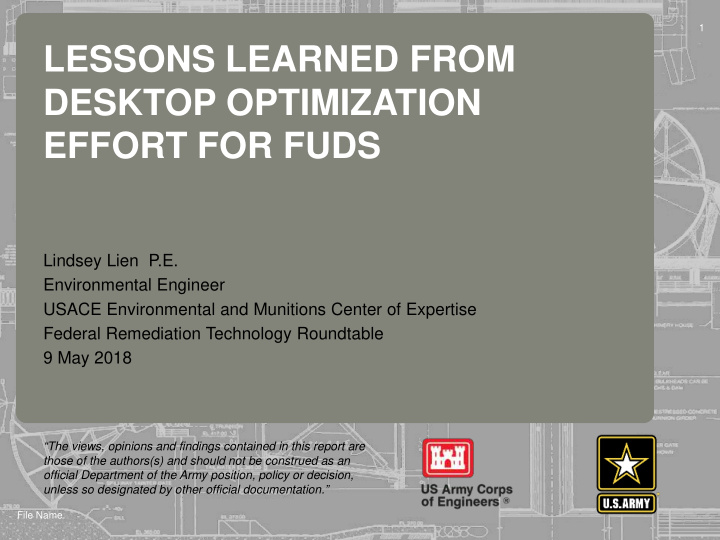



1 LESSONS LEARNED FROM DESKTOP OPTIMIZATION EFFORT FOR FUDS 237 217 200 80 252 237 217 200 119 174 237 217 200 27 .59 255 0 163 131 239 110 112 62 102 130 255 0 163 132 65 135 92 102 56 120 255 0 163 122 53 120 56 130 48 111 Lindsey Lien P.E. Environmental Engineer USACE Environmental and Munitions Center of Expertise Federal Remediation Technology Roundtable 9 May 2018 “The views, opinions and findings contained in this report are those of the authors(s) and should not be construed as an official Department of the Army position, policy or decision, unless so designated by other official documentation.” File Name
PROBLEM STATEMENT Many Formerly Used Defense Sites (FUDS) Ground Water (GW) Sites – Hundreds of Sites Requiring Remediation – Large costs, Long “tails” Need to “Move the Needle” on accelerating closure, reduce cost to complete Traditional optimization studies relatively slow, expensive – Justified for some projects – USACE optimization process: Remediation System Evaluation (RSE) Need fast and efficient process to assess FUDS GW sites
PROPOSED APPROACH Proposed to HQ USACE a rapid “tiger team” approach – Small team (2 person, senior engineers and geologists) – Gather key documents (Decision Document, RI, Operational data, cost, etc.) – Meeting or call with PM/team – Rapid assessment, brief (2-4 page) memo on findings and recommendations • Accelerate closure and reduce cost • Identify common/systemic barriers to progress – Review by district team and possibly their contractor – May recommend RSE if justified Pilot test proposed in FY18
PILOT IMPLEMENTATION Developed standard checklist, report memo outline Reviewed FUDS GW sites in USACE Northwestern Division Chose 14 sites based on discussions with division & district FUDS program managers Studies used readily available documents from internal databases, requested other recent info from PMs - Decision documents - Operational reports - Remedial Investigation reports - Pilot test reports, etc.
5 PILOT IMPLEMENTATION, CONTINUED Teams formed with EM CX engineering & hydrogeology staff One lead technical person - Review materials, complete checklist - Compile plume maps, piezometric maps, cross-sections Meet with other technical tiger team member - Discuss conceptual site model - Review objectives - Brainstorm Lead tiger team member drafts memo - Review by other team member, EM CX PM Transmit the memo & checklist to district team and division
6 PILOT IMPLEMENTATION, CONTINUED Sites considered - Mostly former intercontinental ballistic missile sites (Atlas, Titan) - Former munitions manufacturing site - Former Air Force radar site Contaminants - Chlorinated solvents - Explosives Existing remedies - In-situ bioremediation, chemical oxidation/reduction - Pump & treat at manufacturing site - Monitored natural attenuation
RESULTS AND RECOMMENDATIONS TO DATE Sites are making progress, in some cases quite substantial progress Contractors taking varied approaches to amendment injection, varied success – Direct injection – Recirculation Ground water circulation as option to accelerate cleanup Issues with adequate treatment of source areas – Additional (high resolution) characterization or vertical profiling to target treatment – Offered alternatives, enhancements to accelerate closure
8 RESULTS AND RECOMMENDATIONS TO DATE, CONTINUED Recommended transition to MNA sites treated to plateau levels (or one additional injection event) Difficulties treating fine-grained heterogeneous lithology – Address with aggressive technology, better characterization or alternative RAOs Monitoring optimization recommendations Some sites targeting MCLs for non-potable aquifers (e.g., perched aquifers or low yield shallow unit) Costs under $5,000 per site, expect costs to be further reduced
9 ISSUES IDENTIFIED Follow-up and tracking recommendations • Follow-up encourages implementation of recommendations • Tracking recommendations, implementation for assessing full benefit of effort • Still considering tracking mechanism MCLs used as standards in all groundwater DD - Even when no potential for potable use - Anticipated barrier to achieving “Response Complete” by FY21 - Develop metrics for ending active treatment prior to MNA - Recognizing the need to continue long-term management & monitoring of site https://www.itrcweb.org Resources for continuation of the effort - Planning ~20 sites per FY over 6 years Consider training & transfer of injection guidance
10 CASE STUDY Missile Facility in Nebraska COCs: TCE and daughter products RA: Enhanced Reductive Dechlorination (ERD) RAOs: Restore aquifer to DWS shallow and deep Issues: Large off site plume Right of Entry limitations Potable wells/residences adjacent to the site MNA will not meet DWS by 2021 timeline Recommendations: Use GW recirculation to accelerate cleanup Gain RoE to off site monitoring wells Optimize monitoring program 5/2/2018
Recommend
More recommend